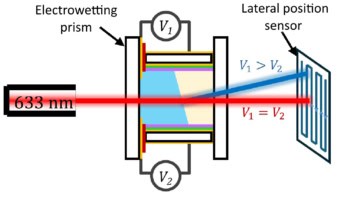
Physicists in the UK and Canada claim to have demonstrated for the first time how a spinning medium can rotate a transmitted image. According to the researchers, the phenomenon could be used to encode images with extra data.
It has long been known that a moving medium can shift the position of passing light. The reason is that the light’s photons can be absorbed by the medium’s atoms, which jump into a higher energy state as a result. A moment later, these atoms return to their original state, re-emitting the photons. But by this time the atoms have moved slightly, so the photons continue their path from that new position.
In 1859 the French physicist Hippolyte Fizeau demonstrated this “photon drag” in the longitudinal direction by shining light through flowing water. More than 100 years later, in 1976, the British physicist Reginald Jones demonstrated it similarly in the transverse direction, by shining light near the edge of a spinning glass disc. But until now, it seems, no-one has ever shown that an image formed by light can be rotated. The problem is that the atoms are so quick to re-emit absorbed photons that the change in an image’s rotation is barely perceptible.
Slowing down light
Sonja Franke-Arnold and colleagues at the University of Glasgow, UK, have joined forces with physicists at the University of Ottawa, Canada, to perform the feat by relying on another phenomenon: slow light. Many media slow down light a little from its usual speed of 3 × 108 m/s in a vacuum. However, in a few media, given the right conditions, the speed – the light’s group velocity, not that of the individual photons – can be reduced dramatically. Because slow light takes so much longer to pass through a medium, any photon drag should be enhanced.
To test this idea, Franke-Arnold’s group shone a rectangular beam of green light into a cylinder made of ruby, which they spun at up to 30 revolutions per second. Ruby is a well known slow-light material, and transmits light with a group velocity of just a few tens of metres per second. By changing the rotation of the ruby from clockwise to counter-clockwise, the researchers could detect a rotation of the light rectangle by about one-third of a degree (see figure). What is more, when they ramped up the intensity of the light, the rectangle’s rotation increased to about 10° – probably because the photons were then undergoing several absorption and re-emission cycles.
“Very beautiful demonstration”
Ortwin Hess, an expert in slow light at Imperial College London and the University of Surrey, calls it a “very beautiful demonstration” of rotary photon drag. He suggests that the phenomenon could be extended to a broad range of wavelengths using special man-made media known as metamaterials. “It’s very interesting, indeed,” he says.
Franke-Arnold’s group believes that one application could be in image encoding: just as the intensity of an image supplies data, so too could the image’s rotation. For now, however, the researchers are keen to further investigate rotary photon drag. “We have a few ideas – like more complex images,” says Miles Padgett, of the University of Glasgow, who was also involved in the work.
The paper was published last week in Science 333 65.



